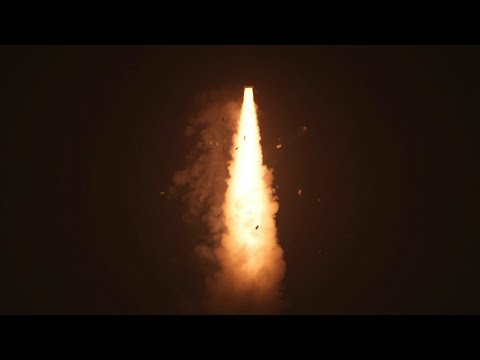HELSINKI — China conducted a pair of solid rocket launches late Saturday, seeing the country surpass its previous record for orbital launch attempts in a calendar year.
A Long March 11 solid rocket lifted off at 4:01 p.m. Eastern (2101 UTC), Nov. 8, from a mobile launch platform off the coast of Haiyang, Shandong Province. Confirmation of launch success did not come from the China Aerospace Science and Technology Corporation (CASC) until nearly eight hours after launch, despite successful missions typically being declared around an hour after liftoff, depending on orbits, payloads and launchers. The delay prompted speculation of an issue with either launcher or payload.
CASC eventually declared the launch a success, revealing the payloads to be the Shiyan-32 (01, 02 and 03) satellites. The space and defense giant described the satellites as “primarily used for conducting experiments on new space technologies,” providing no further details. The Innovation Academy for Microsatellites of the Chinese Academy of Sciences (IAMCAS) developed the 02 satellite.
Shiyan missions are typically opaque, but outside analysts believe Shiyan satellites are used to trial new systems such as sensors, communications subsystems and environmental instruments, forming part of China’s efforts to validate new space technologies in orbit.
Satellites in the series appear to have been used for a range of purposes, including technology demonstrations, space environment monitoring, electronic intelligence, remote sensing, space situational awareness and space operations such as rendezvous and proximity maneuvers (RPO).
Previous missions saw Shiyan-31 launch on a Long March 2D with a wider 4.0-meter-diameter fairing Oct. 13, entering a 495 by 510-kilometer orbit inclined by 80 degrees, while a stage filmed impacting the ground, and Shiyan-30 (01) and (02) launched Sept. 29.
Kinetica-1 launches VLEO satellites
The mission was followed just hours later by a launch by commercial outfit CAS Space.
A Kinetica-1 solid rocket lifted off at 10:32 p.m. Eastern, Nov. 8 (0332 UTC, Nov. 9) from Dongfeng Commercial Space Innovation Test Area at Jiuquan Satellite Launch Center, northwest China. The mission carried the Chutian-2 technology experiment satellites 01 and 02.
The satellites were China Aerospace Science and Industry Corporation (CASIC) Space Engineering Development, a subsidiary of CASIC’s second academy.
The Chutian constellation has been described as a key project for the Wuhan commercial aerospace chain and a test of a Very Low Earth Orbit (VLEO) constellation, aiming to verify Earth observation capabilities and high resolution processing. China Daily describes the satellites as for testing Earth observation and hyper-resolution processing and application capabilities.
Operating in VLEO enables higher ground resolution and reduced latency, but requires active drag compensation or short service lifetimes, making Chutian likely a test of propulsion, aerodynamics and operational cadence.
Display models associated with the series depict a bullet-shaped body designed to reduce drag, operating at low altitudes in which atmospheric drag is much greater. A Chutian-001 test satellite launched on a Kuaizhou-11 in May 2024, and appears to have reentered May 20, 2025.
CAS Space says it aims to launch another Kinetica-1 rocket in late November, along with a first suborbital flight of the Lihong-1 rocket which is being developed for suborbital tourism.
New launch record
The pair of launches were China’s 69th and 70th orbital launches of 2025, meaning the country surpassed its previous record for launch attempts in a calendar year of 68, set in 2024, with nearly two months remaining in the year.
23 of the launches have been from Jiuquan—once again the busiest spaceport in China—up from the 22 across the whole of 2024. Xichang is currently on 16 (19 across 2024). Wenchang and the nearby Hainan commercial spaceports are hosting more launches than last year.
The numbers show a drop in the proportional use of the older, hypergolic Long March 2, 3 and 4 series rockets (32 in 2024) with 26 launches so far this year, with growing use of kerosene or liquid hydrogen Long March 5, 6, 7 and 8 launchers (24).
Overall, CASC’s Long March rockets have accounted for around three-quarters of all launches (51), with state-owned enterprise-affiliated commercial launchers Kinetica-1 (CAS Space), Jielong-3 (China Rocket) and Kuaizhou series (CASIC) totaling 10 launches, and nine further launches from commercial outfits Galactic Energy, Landspace, iSpace and Gravity Space. Launches for the Guowang and Qianfan/Thousand Sails constellations have driven some of the growth in launch.
The next launches out of China are due soon, with a Long March 12 rocket scheduled to launch from Hainan commercial spaceport later Nov. 9 Eastern at around 10:00 p.m. (~0300 UTC, Nov. 10) and Galactic Energy Ceres-1 solid rocket from Jiuquan at around 11:05 p.m. Eastern Nov. 9 (~0405 UTC, Nov. 10). The debut of the larger Ceres-2 is currently expected Nov. 15.
At time of reporting the expected return to Earth of the Shenzhou-20 astronauts had been delayed (Nov. 5) due to a potential debris impact. China’s human spaceflight agency is still assessing the situation.

